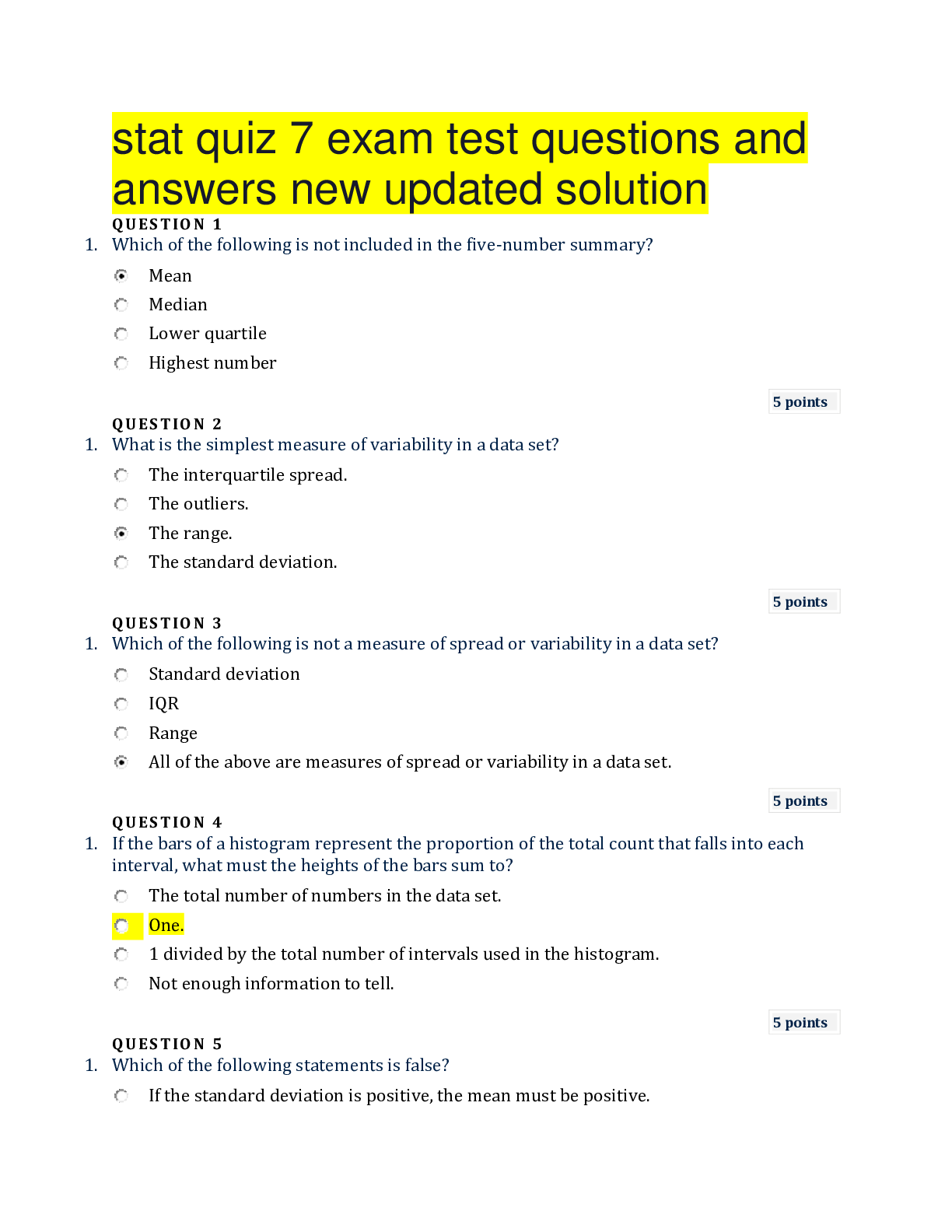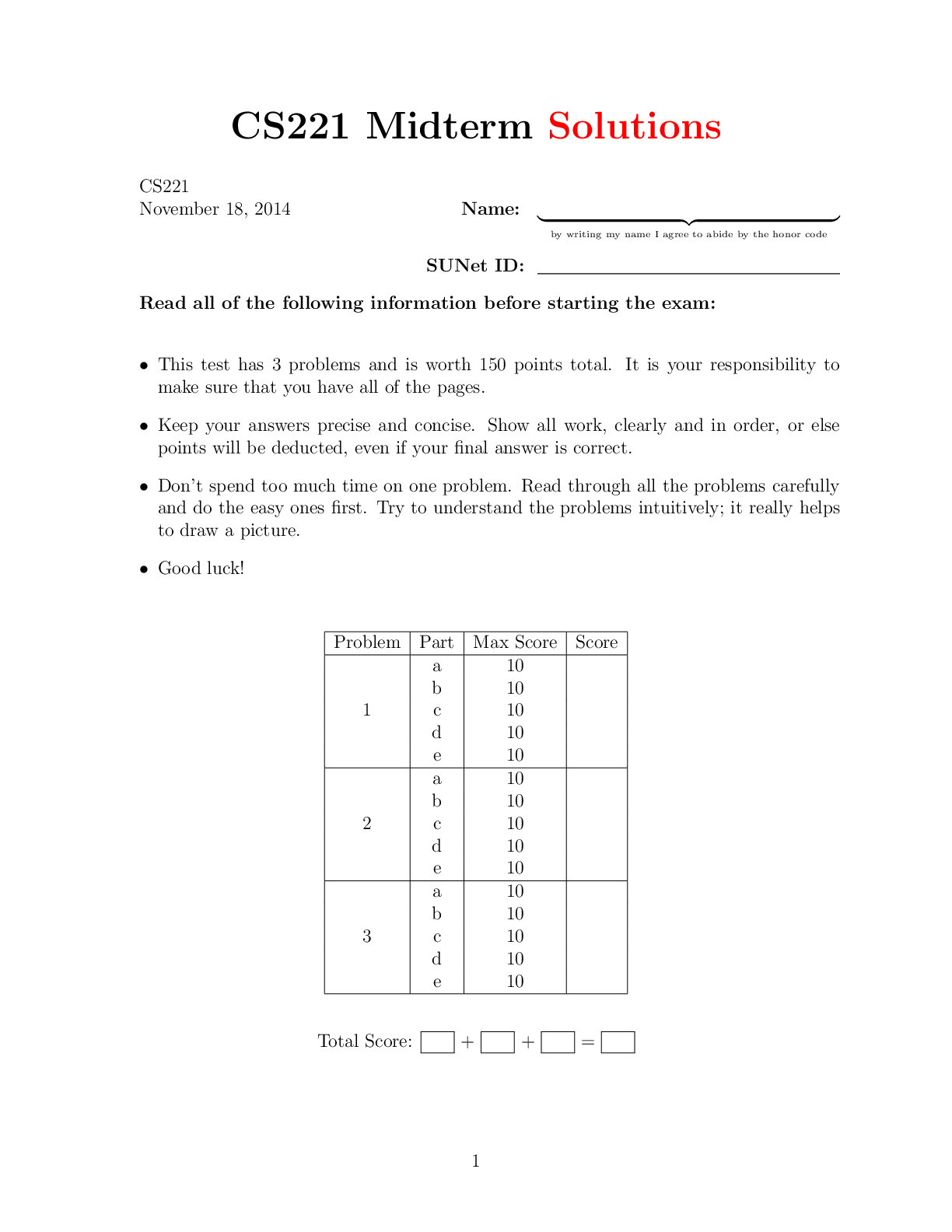
stat quiz 7 exam test questions and answers new updated solution
Statistics > EXAM REVIEW > Stanford University - CS 221exam-2014-solution. (All)
CS221 Midterm Solutions CS221 November 18, 2014 Name: | {z } by writing my name I agree to abide by the honor code SUNet ID: Read all of the following information before starting the exam: • ... This test has 3 problems and is worth 150 points total. It is your responsibility to make sure that you have all of the pages. • Keep your answers precise and concise. Show all work, clearly and in order, or else points will be deducted, even if your final answer is correct. • Don’t spend too much time on one problem. Read through all the problems carefully and do the easy ones first. Try to understand the problems intuitively; it really helps to draw a picture. • Good luck! Problem Part Max Score Score 1 a 10 b 10 c 10 d 10 e 10 2 a 10 b 10 c 10 d 10 e 10 3 a 10 b 10 c 10 d 10 e 10 Total Score: + + = 1 1. Enchaining Realm (50 points) This problem is about machine learning. a. (10 points) Suppose we want to predict a real-valued output y ∈ R given an input x = (x1, x2) ∈ R 2 , which is represented by a feature vector φ(x) = (x1, |x1 − x2|). Consider the following training set of (x, y) pairs: Dtrain = {((1, 2), 2),((1, 1), 1),((2, 1), 3)}. (1) We use a modified squared loss function, which penalizes overshooting twice as much as undershooting: Loss(x, y, w) = ( 1 2 (w · φ(x) − y) 2 if w · φ(x) < y (w · φ(x) − y) 2 otherwise (2) Using a fixed learning rate of η = 1, apply the stochastic gradient descent algorithm on this training set starting from w = [0, 0] after looping through each example (x, y) in order and performing the following update: w ← w − η ∇wLoss(x, y, w). (3) For each example in the training set, calculate the loss on that example and update the weight vector w to fill in the table below: x φ(x) Loss(x, y, w) ∇wLoss(x, y, w) weights w Initialization n/a n/a n/a n/a [0, 0] After example 1 (1,2) After example 2 (1,1) After example 3 (2,1) Solution x φ(x) Loss(x, y, w) ∇wLoss(x, y, w) weights w Initialization n/a n/a n/a n/a [0, 0] After example 1 (1,2) (1,1) 2 [−2, −2] [2, 2] After example 2 (1,1) (1,0) 1 [2, 0] [0, 2] After example 3 (2,1) (2,1) 0.5 [−2, −1] [2, 3] [Show More]
Last updated: 3 years ago
Preview 1 out of 27 pages

Buy this document to get the full access instantly
Instant Download Access after purchase
Buy NowInstant download
We Accept:

Can't find what you want? Try our AI powered Search
Connected school, study & course
About the document
Uploaded On
Apr 17, 2021
Number of pages
27
Written in
All
This document has been written for:
Uploaded
Apr 17, 2021
Downloads
0
Views
183
Scholarfriends.com Online Platform by Browsegrades Inc. 651N South Broad St, Middletown DE. United States.
We're available through e-mail, Twitter, Facebook, and live chat.
FAQ
Questions? Leave a message!
Copyright © Scholarfriends · High quality services·